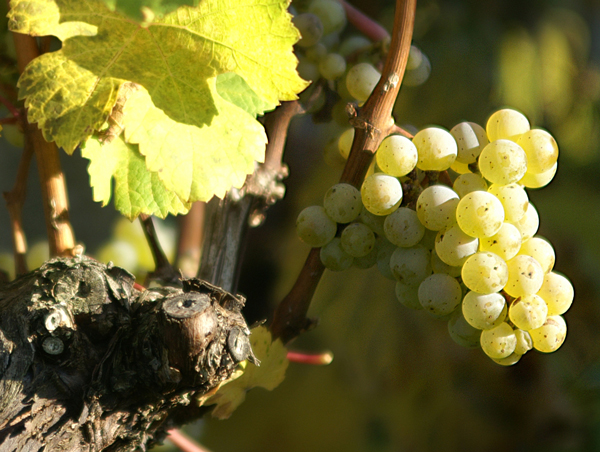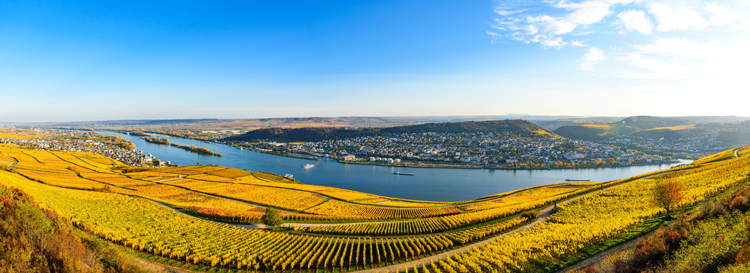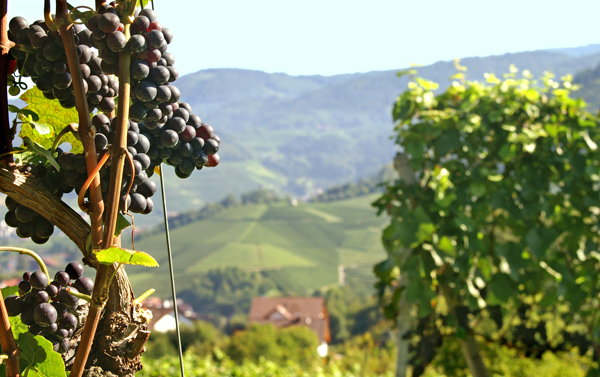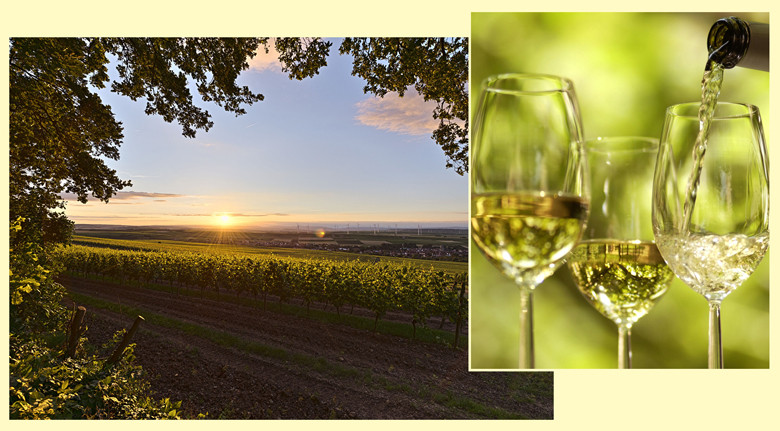German white wines popular
As a medium-sized production country at best, German viticulture can by no means meet the demand of the large German market alone. A lot has to be imported. The market share of German wines in 2022 was 44% by volume and 47% by value, which means, however, that the appreciation of domestic wines is somewhat higher in comparison. Of German wines, mainly white wines are drunk, increasingly now almost 60%, although the total demand for white wines is declining slightly and is around 40%. So it can be said somewhat pointedly: "A good white wine is a German!"
Varieties and types of German white wines
The trend towards German white wines is also reflected in the development of vineyards. For example, the total white wine area increased by 6,000 hectares from 2006 to 2023 to 71,378 hectares and is 69%. The trends in the varieties planted also show which wines are popular and liked to drink.
Riesling – the typical German (white) wine
 Riesling. photo: bonvinitas
Riesling. photo: bonvinitas
Riesling, which in principle produces more elegant wines that are not too heavy with alcohol, is really popular and, according to the latest survey by the Federal Statistical Office, remains the undisputed No. 1 in 2023 with around 24,400 hectares, which means that it occupies almost a quarter of Germany's total vineyard area of 103,687 hectares.
White Burgundy varieties
A lot is happening there, and these wines are also very popular. First and foremost
Pinot Gris with its strong, somewhat milder wines, which is the third most important white variety in Germany of 8,372 hectares with an impressive increase of 278 ha compared to 2022, followed by
Pinot Blanc with 6,318 hectares. This one, which tends to bring somewhat creamier wines with glaze, has also increased by 137 hectares over the year.
Chardonnay is interesting with its fuller-bodied wines, which has increased by almost 7% over the year to 2,912 hectares and is also more widely considered a white Burgundy variety. If
Auxerrois is added with its more tender wines, the white burgundy varieties have come altogether to almost 18,000 hectares and are occupying with 17.4% No. 2 after Riesling.
Mueller-Thurgau, also known as Rivaner, which brings nice table and a glass of wines, cannot be unmentioned. It is not unpopular with winegrowers because it bears well and does not make high demands on its location, which cannot be said of Riesling in general. Although the Mueller-Thurgau area is decreasing, it still comes to remarkable 10,738 hectares in 2023. Also worth mentioning is Silvaner with its more discreet wines as a good and not too cheeky food companion, which still has 4,330 hectares.
 Vines in the Rheingau with a view of the Rhine. The towns: Ruedesheim in the background on the left, Bingen opposite. photo credit: Mikalai Zastsenski - Adobestock
Vines in the Rheingau with a view of the Rhine. The towns: Ruedesheim in the background on the left, Bingen opposite. photo credit: Mikalai Zastsenski - Adobestock
Exports confirm the trends
A lot has happened here as well. Good German wines are attracting increasing international attention. More and more, the image of German wines is moving away from sweet cheap wines that have been exported. For example, average export prices rose by around 228% between 2000 and 2022, whereas the general euro prices have increased in Germany at the same time only around 150%. This expresses the increasing appreciation of German wines. In exports, too, the focus is on white wines, which is even more evident with a share of 84%. Overall, the export share has averaged around 13% in recent years. I think that the winegrowers concerned can be proud of the increasing appreciation of German wines.
The red wines – Pinot Noir, the typical German
 Pinot Noir in Waldulm at the Black Forest's edge. photo credit: bonvinitas
Pinot Noir in Waldulm at the Black Forest's edge. photo credit: bonvinitas
Over the year, the red wine area fell by 1% to 32,310 hectares in 2023 and counts around 31% of Germany's vineyard area. On the other hand, the Pinot Noir, which is bringing fruity and elegant red wines that are not too peppery, and is in the foreground with around 11,500 hectares. With over 35% of the red wine area, it is the most important red variety in Germany, of which almost the half grows in Baden.
This is followed by Dornfelder and Blauer Portugieser, both on the march back, as well as Lemberger with only a slight decrease.
The cultivation of the international red wine varieties Merlot, Cabernet Sauvignon and Syrah is increasing, albeit still at a low level.
PIWI varieties – growth champion: Souvignier Gris
 Souvignier Gris. photo credit: Rebschule Freytag
Souvignier Gris. photo credit: Rebschule Freytag
The fungus-resistant, the so-called PIWI varieties, which require significantly less pest management and thus offer a whole range of advantages in matters of sustainability, are becoming increasingly well-known. The growth champion with almost 90% plus over the year is the white Souvignier Gris, which delivers wines of the Riesling type. Even though its area of 388 hectares is still modest, PIWI varieties, which also include the white Cabernet Blanc, Muscaris and Solaris, form an important piece of the viticulture’s future
Of course, only the most important varieties are mentioned. There are many more, but the most important ones are showing the trends.
Text: Dieter Simon, publisher and editor-in-chief bonvinitas.
Sources: German Wine Institute, Federal Statistical Office; Euro currency devaluation: www.hermoney.de
Photos as indicated.
 Vines in the Rheingau with a view of the Rhine. The towns: Ruedesheim in the background on the left, Bingen opposite. photo credit: Mikalai Zastsenski - Adobestock
Vines in the Rheingau with a view of the Rhine. The towns: Ruedesheim in the background on the left, Bingen opposite. photo credit: Mikalai Zastsenski - Adobestock
 Pinot Noir in Waldulm at the Black Forest's edge. photo credit: bonvinitas
Pinot Noir in Waldulm at the Black Forest's edge. photo credit: bonvinitas
 Souvignier Gris. photo credit: Rebschule Freytag
Souvignier Gris. photo credit: Rebschule Freytag






